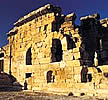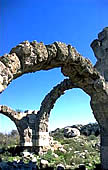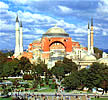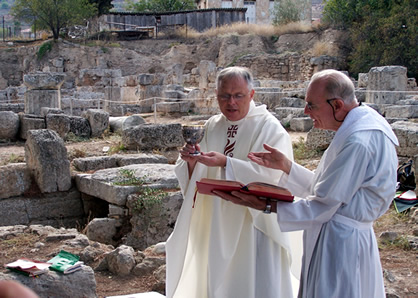Biblical Asia Minor Tour (13 Nights/14 Days)
Key Information
Tour Duration: 13 nights / 14 days

Days of Operation: Private Tour - Regular Tour
Destination's: Turkey
Hotel's Class: 5, 4, 3 Stars Hotel or Tourist Class
Season: All Years 2026
Scheduled / Operates on: Jan 1st 2026 - Dec 31st 2026. All years Biblical Tours Turkey
Domestic Flight Included: Yes
Tour Customizable: Yes
*Overnight Place:
3 nights Istanbul, 1 night Antioch, 2 nights Cappadocia, 1 night
Konya, 1 night Pamukkale
1 night Izmir, 2 night Kusadasi, 1 night Pergamum, 1 night Bursa.

Tour Itinerary:
Day 1: Istanbul.
Upon arrival at Istanbul's International Airport, you will
be met by one of our bilingual guides, who will assist you during
your transfer to the hotel. Orientation walks. overnight
in Istanbul.
Day 2: Adana - Tarsus - Seleucia - Antioch.
Early morning flight to Adana, the country's fourth largest city.
Adana is situated some thirty miles east of Tarsus, birthplace of
the Apostle Paul. Enjoy breakfast in your hotel, then drive to
Tarsus and visit the Apostle Paul's well, the Gate of Cleopatra, and
the latest excavations. Then we visit the archaeological remains of
Seleucia, the port from which Paul, Barnabas and John Mark departed
from Antioch on the first missionary journey (Acts 13:4). Drive to
Antioch for overnight. Including: Breakfast
Day 3: Antioch - Cappadocia.
It was here at Antioch on the Orontes that believers were first
called Christians (Acts 11:26). Visit the cave where they met in
secret. Paul and Silas departed from here on the second missionary
journey (Acts 15:35-36). Discover the impact of leaders such as
Ignatius of Antioch and John Chrysostom. In Acts 2:9, pilgrims from
Cappadocia were assembled with the thousands in Jerusalem on the Day
of Pentecost when they received the initial baptism of the Holy
Spirit and heard the Apostle Peter preach his powerful message. We
will travel to Cappadocia scenic Ihlara Valley, where early
Christians carved some 3,500 cave churches from the tufa rock. The
beauty and quaintness of these chapels, with numerous wall paintings
and Christian symbols, is astonishing. Persecuted Christians - tens
of thousands of them - escaping into the earth to flee Arab invaders
in the tenth century, tunneled out more than twenty underground
cities of refuge here in Cappadocia. Such cities, with carved rooms
for kitchens, sleeping quarters, stables, and chapels for worship,
descend five to ten stories into the earth. At Kaymakli, one of the
best preserved of these cities, you will enjoy your own guided tour
into this amazing region. Overnight in a Cappadocia. Including: Breakfast

Day 4: Cappadocia.
Cappadocia, with its centre in Caesarea (Kayseri), was once the
heart of the Hittite Kingdom of the Old Testament. This vast area is
one of the most photogenic landscapes in the world. Extraordinary
rock formations have become symbolic of this region, where you will
enjoy the Valley of the Fairy Chimneys and Goremes breathtaking
Open Air Museum. Watch the potters at their craft, in the famous
pottery producing town of Avanos. Finally, savor the natural wonders
of the Citadel of Uchisar and Zelve Valley. Overnight in a
Cappadocia. Including: Breakfast
Day 5: Sultanhan - Lystra - Iconium.

Drive to the Sultanhani Caravansary for a fascinating look at one of
the rest stops for ancient camel caravans. Along the trade routes,
such caravansaries appeared at intervals of some twenty-five miles,
the average distance that camels could travel in a day. Continue on
to Lystra, where a mob stoned Paul during his first journey (Acts
14:6-19), and where Timothy joined him during the second journey
(Acts 16:1-3). Depart for Iconium, where Paul preached and
encouraged believers during his first missionary journey (Acts
14:1-6). Iconium was once the home of the sect of mystical Muslims
called Whirling Dervishes. Overnight in a Konya. Including: Breakfast
Day 6: Antioch of Pisidia - Colossae - Hierapolis.
Drive to Antioch of Pisidia, where nearly the whole city came to
hear Paul preach during his first missionary journey (Acts
13:14-52). The marvelous excavations include the ancient church and
the great first-century Temple of Augustus. Today, you will travel
the Royal Road that once
 connected
Ephesus with distant Babylon. Visit the unexcavated site of ancient
Colossae by the village of Honaz. The Apostle Paul wrote one of his
prison epistles to the church at Colossae, a city situated on the
Lycus River. At Hierapolis (Pamukkale), enjoy the Cotton Castles
of brilliant white calcium rock formations and hot-water
travertine's, where hot mineral waters emerge from the earth and
cascade over cliffs. As the water cools, the calcium precipitates
and clings to the cliffs, forming snowy white travertine's
(waterfalls of
connected
Ephesus with distant Babylon. Visit the unexcavated site of ancient
Colossae by the village of Honaz. The Apostle Paul wrote one of his
prison epistles to the church at Colossae, a city situated on the
Lycus River. At Hierapolis (Pamukkale), enjoy the Cotton Castles
of brilliant white calcium rock formations and hot-water
travertine's, where hot mineral waters emerge from the earth and
cascade over cliffs. As the water cools, the calcium precipitates
and clings to the cliffs, forming snowy white travertine's
(waterfalls of white stone), which give credence to the name Pamukkale, meaning
cotton castle . This enchanting place is one of the natural
wonders of Asia Minor. The churches here in Hierapolis, Colossae,
and Laodicea once flourished under the ministry of Epaphras
(Colossians 4:12-13). Overnight stay in Pamukkale. Including: Breakfast
white stone), which give credence to the name Pamukkale, meaning
cotton castle . This enchanting place is one of the natural
wonders of Asia Minor. The churches here in Hierapolis, Colossae,
and Laodicea once flourished under the ministry of Epaphras
(Colossians 4:12-13). Overnight stay in Pamukkale. Including: Breakfast
Day 7: Hierapolis - Laodicea - Philadelphia - Sardis - Smyrna.
Explore incredible excavations at Hierapolis, including a Byzantine
church, the Great Theatre, the Temple of Apollo, and the Plutonium,
which pagan cults once called the entrance to hell. Examine the
intriguing sites of the Churches of Revelation. Laodicea (Rev.
3:14-22) will take you back to the first century. At Philadelphia
(Rev. 3:7-12), your Bible will come alive as you read it in light of
firsthand study. This city was located along the important trade
route that linked Pergamum
 in
the north with Laodicea to the south. In A.D. 17, an earthquake
devastated twelve Asian cities, including Philadelphia, and for a
time the people lived in fear of aftershocks. Philadelphia was
rebuilt with help from Emperor Tiberius. At Sardis (Rev. 3:1-5),
your thoughts will turn to the Old Testament period following the
586 B.C. destruction of Jerusalem. That was the time when the phrase
rich as Croesus originated. Croesus (560-546 B.C.) was the king of
Lydia, and Sardis was his capital. Gold was discovered in the
Pactolus River at Sardis and it was here that coinage began, as we
know it. Cyrus and the Persians defeated and captured Croesus for
all his wealth and made Sardis the administrative centre for the
western part of their empire. The fabled Royal Road connected Sardis
with the Persian cities to the east. Sardis was the hardest hit of
the twelve cities destroyed in the earthquake of A.D. 17. Emperor
Tiberius, according to the Annals of the historian Tacitus, gave
much relief towards its rebuilding. Your visit to Sardis will
include the imperial court and the ancient Jewish synagogue. You
will rest in the shade of the Temple of Artemis, while studying in
the light of prophetic Scripture. Overnight stay in
Izmir. Including: Breakfast
in
the north with Laodicea to the south. In A.D. 17, an earthquake
devastated twelve Asian cities, including Philadelphia, and for a
time the people lived in fear of aftershocks. Philadelphia was
rebuilt with help from Emperor Tiberius. At Sardis (Rev. 3:1-5),
your thoughts will turn to the Old Testament period following the
586 B.C. destruction of Jerusalem. That was the time when the phrase
rich as Croesus originated. Croesus (560-546 B.C.) was the king of
Lydia, and Sardis was his capital. Gold was discovered in the
Pactolus River at Sardis and it was here that coinage began, as we
know it. Cyrus and the Persians defeated and captured Croesus for
all his wealth and made Sardis the administrative centre for the
western part of their empire. The fabled Royal Road connected Sardis
with the Persian cities to the east. Sardis was the hardest hit of
the twelve cities destroyed in the earthquake of A.D. 17. Emperor
Tiberius, according to the Annals of the historian Tacitus, gave
much relief towards its rebuilding. Your visit to Sardis will
include the imperial court and the ancient Jewish synagogue. You
will rest in the shade of the Temple of Artemis, while studying in
the light of prophetic Scripture. Overnight stay in
Izmir. Including: Breakfast
Day 8: Smyrna - Miletos - Didyma.
Visit the ramparts of Smyrnas Velvet Castle, built in the fourth
century B.C. by Alexander the Great on Mount Pagus. (The fortress walls were said to resemble
rubbed velvet.) During the first Christian century, in the stadium
that once stood on the hill below Mount Pagus, Polycarp, friend of
the Apostle John and pastor of the church at Smyrna, was arrested by
the Roman governor and tried in a public gathering. An angry mob
burned him for treason. He had refused to curse Christ and to
acknowledge Caesar as his sovereign. Just before his martyrdom,
Polycarp said, "Eighty six years I have served Christ and He never
did me any wrong: how then can I blaspheme my King and my Saviour?"
Still standing is part of the agora built by Emperor Marcus Aurelius
in the third century. Today, Smyrna is the country's major Aegean
port and third largest city. Drive to Miletus, home of ancient
philosopher Thales (640-546 B.C.), one of the fathers of Greek
geometry, astronomy, and philosophy.
Great on Mount Pagus. (The fortress walls were said to resemble
rubbed velvet.) During the first Christian century, in the stadium
that once stood on the hill below Mount Pagus, Polycarp, friend of
the Apostle John and pastor of the church at Smyrna, was arrested by
the Roman governor and tried in a public gathering. An angry mob
burned him for treason. He had refused to curse Christ and to
acknowledge Caesar as his sovereign. Just before his martyrdom,
Polycarp said, "Eighty six years I have served Christ and He never
did me any wrong: how then can I blaspheme my King and my Saviour?"
Still standing is part of the agora built by Emperor Marcus Aurelius
in the third century. Today, Smyrna is the country's major Aegean
port and third largest city. Drive to Miletus, home of ancient
philosopher Thales (640-546 B.C.), one of the fathers of Greek
geometry, astronomy, and philosophy.
 It
was here, in the first Christian century, that the Apostle Paul, on
his third missionary journey, called for the Ephesians elders and
preached a powerful message to them (Acts 20:15-38). It was also
here that Paul left his friend Trophimus, who was too ill to
continue (II Timothy 4:20 ). As a port at the mouth of the Meander
River, Miletus was a natural outlet for Phrygian trade. Like the one
at Ephesus, however, Miletuss sea harbour eventually filled with
silt, and commerce dwindled. The city's remote quietness makes it
special to devout students of Scripture. Its ancient ruins include
the marvelous 15,000-seat theatre. Nearby, at Didyma, visit the
massive Temple to Apollo, one of the most impressive sites in
Anatolia. Ordinary people did not reside in ancient Didyma. This was
home only to a priestly family whose oracle came from Delphi and who
lived in luxury, as they guarded their temple treasuries supplied by
the people they deceived. Continue to Kusadasi for overnight. Including: Breakfast
It
was here, in the first Christian century, that the Apostle Paul, on
his third missionary journey, called for the Ephesians elders and
preached a powerful message to them (Acts 20:15-38). It was also
here that Paul left his friend Trophimus, who was too ill to
continue (II Timothy 4:20 ). As a port at the mouth of the Meander
River, Miletus was a natural outlet for Phrygian trade. Like the one
at Ephesus, however, Miletuss sea harbour eventually filled with
silt, and commerce dwindled. The city's remote quietness makes it
special to devout students of Scripture. Its ancient ruins include
the marvelous 15,000-seat theatre. Nearby, at Didyma, visit the
massive Temple to Apollo, one of the most impressive sites in
Anatolia. Ordinary people did not reside in ancient Didyma. This was
home only to a priestly family whose oracle came from Delphi and who
lived in luxury, as they guarded their temple treasuries supplied by
the people they deceived. Continue to Kusadasi for overnight. Including: Breakfast
Day 9: Ephesus.
Ephesus (Rev. 2:1-7), major port city on the Aegean, was the
commercial, political, and religious centre of all of Asia Minor.
After a lunatic completely burned the Temple of Diana (Artemis) on
 the
night that Alexander the Great was born in 356 B.C., the Ephesians
worked for 120 years to complete a magnificent reconstructed temple,
one of the Seven Wonders of the ancient world. The city became part
of the Roman Empire in the second century B.C. As a Roman capital of
Asia Minor, Ephesus boasted a population approaching 250,000 people.
The Apostle Paul's first visit to Ephesus was briefduring his
second missionary tour (Acts 18:19-21). His second visit lasted
about three yearsduring his third missionary tour (Acts 19:1 to
20:31). Lukes account of the worship of Diana appears in Acts
19:34-35. The Great Theatre (stadium) mentioned in Acts 19:29-31
could seat 25,000 people. Walk the marble-paved street with grooves
made by chariot wheels. See the Fountain of Trojan, the Library of
Celsus and the Great Theatre. Visit the Chapel of the Virgin Mary
(Double Church), where the Third Ancient Council convened. Enjoy St.
John's Basilica (built on the site of the Apostle Johns tomb) and
ponder the remains of the Temple of Diana. Finally, enjoy a visit to
the Ephesus Museum. Overnight Kusadasi. Including: Breakfast
the
night that Alexander the Great was born in 356 B.C., the Ephesians
worked for 120 years to complete a magnificent reconstructed temple,
one of the Seven Wonders of the ancient world. The city became part
of the Roman Empire in the second century B.C. As a Roman capital of
Asia Minor, Ephesus boasted a population approaching 250,000 people.
The Apostle Paul's first visit to Ephesus was briefduring his
second missionary tour (Acts 18:19-21). His second visit lasted
about three yearsduring his third missionary tour (Acts 19:1 to
20:31). Lukes account of the worship of Diana appears in Acts
19:34-35. The Great Theatre (stadium) mentioned in Acts 19:29-31
could seat 25,000 people. Walk the marble-paved street with grooves
made by chariot wheels. See the Fountain of Trojan, the Library of
Celsus and the Great Theatre. Visit the Chapel of the Virgin Mary
(Double Church), where the Third Ancient Council convened. Enjoy St.
John's Basilica (built on the site of the Apostle Johns tomb) and
ponder the remains of the Temple of Diana. Finally, enjoy a visit to
the Ephesus Museum. Overnight Kusadasi. Including: Breakfast
Day 10: Thyatira - Pergamum.
Today, we will visit our final two of the Seven Churches of
Revelation. At Thyatira (Rev. 2: 18-28), you will see the ruins of
an ancient commercial centre, located in the fertile valley where t he
trade route passed. One of the town's cloth and dye merchants was a
woman named Lydia, who conducted business as far away as Philippi,
where she became the first European convert to Christianity, during
Paul's second missionary journey (Acts 16:11-15). A most memorable
experience will be Pergamum, with its acropolis and Great Theatre,
the steepest of the ancient world. Revelation 2:12-16 describes the
city as where Satans seat is, a reference to the altar of Zeus,
where we pause for reflection on the fulfillment of Scripture.
Nearby, visit the Red Basilica; once a pagan temple, it later
converted into a Christian church. Finally, walk thru the Pergamum
Asclepion, the famous medical centre of antiquity. Overnight in
Pergamum. Including: Breakfast
he
trade route passed. One of the town's cloth and dye merchants was a
woman named Lydia, who conducted business as far away as Philippi,
where she became the first European convert to Christianity, during
Paul's second missionary journey (Acts 16:11-15). A most memorable
experience will be Pergamum, with its acropolis and Great Theatre,
the steepest of the ancient world. Revelation 2:12-16 describes the
city as where Satans seat is, a reference to the altar of Zeus,
where we pause for reflection on the fulfillment of Scripture.
Nearby, visit the Red Basilica; once a pagan temple, it later
converted into a Christian church. Finally, walk thru the Pergamum
Asclepion, the famous medical centre of antiquity. Overnight in
Pergamum. Including: Breakfast
Day 11: Troy - Troas - Assos - Bursa.
Enjoy a fascinating visit to recent excavations of ancient Troy,
made legendary by Homers story of Helen and the Trojans wooden
horse. Then drive to Troas, founded about 300 B.C. by one o f
the generals of Alexandria the Great. During the Apostle Paul's
second missionary journey, it was from Troas that he received the
Macedonian call to Europe. This is where Luke's account changes
from they to we (Acts 16:6-12), indicating that he joined Paul's
team at Troas. Returning from Macedonia during his third journey,
Paul was in Troas for a week, when the young man Eutychus fell from
the third loft as Paul preached. Paul soon walked some thirty miles
to Assos, where we will follow the apostles footsteps to the old
city walls (Acts 20:5-14). You will walk the old marketplace of
Assos and see the council chamber and Temple to Athena. Continue on
to Bursa for a visit to its centuries-old silk market. Overnight in
Bursa. Including: Breakfast
f
the generals of Alexandria the Great. During the Apostle Paul's
second missionary journey, it was from Troas that he received the
Macedonian call to Europe. This is where Luke's account changes
from they to we (Acts 16:6-12), indicating that he joined Paul's
team at Troas. Returning from Macedonia during his third journey,
Paul was in Troas for a week, when the young man Eutychus fell from
the third loft as Paul preached. Paul soon walked some thirty miles
to Assos, where we will follow the apostles footsteps to the old
city walls (Acts 20:5-14). You will walk the old marketplace of
Assos and see the council chamber and Temple to Athena. Continue on
to Bursa for a visit to its centuries-old silk market. Overnight in
Bursa. Including: Breakfast
Day 12: Nicea - Istanbul.
At Nicea, you will see remains of Constantines palace, now covered
by the water at the shore of Lake Iznik. It was here in this palace chapel that the First
Ancient Church Council convened in A.D. 325 to produce the Nicene
Creed. Enjoy Niceas St. Sophia Church, where the Seventh Church
Council convened in 787. Istanbul, the worlds only city that spans two continents,
was originally "Byzantium;" it became "Constantinople" in A.D. 330,
when Emperor Constantine renamed it for himself and built a palace
here. It became "Istanbul" in 1453. Experience the unique markets,
peddlers, and stalls selling almonds, pistachios, iced drinks, and
black coffee - a vigorous anthill of Turkish life. Relax on a
Bosphorus cruise on a private boat. Finally, enjoy an orientation
drive of the city. Overnight in Istanbul. Including: Breakfast
of Lake Iznik. It was here in this palace chapel that the First
Ancient Church Council convened in A.D. 325 to produce the Nicene
Creed. Enjoy Niceas St. Sophia Church, where the Seventh Church
Council convened in 787. Istanbul, the worlds only city that spans two continents,
was originally "Byzantium;" it became "Constantinople" in A.D. 330,
when Emperor Constantine renamed it for himself and built a palace
here. It became "Istanbul" in 1453. Experience the unique markets,
peddlers, and stalls selling almonds, pistachios, iced drinks, and
black coffee - a vigorous anthill of Turkish life. Relax on a
Bosphorus cruise on a private boat. Finally, enjoy an orientation
drive of the city. Overnight in Istanbul. Including: Breakfast
Day 13: Istanbul.
Todays visits begin with Istanbuls Hippodrome, once a stadium with
100,000 seats, where chariot races and circuses often degenerated
into violence. Visit the nearby Blue Mosque. The Se cond
Church Council (381) met in the Church of St. Irene, the first
church ever built in Istanbul. You will visit the fifteenth-century
Topkapi Palace of the Ottoman Sultans. In the first court of this
palace stands the Church of St. Irene, the citys cathedral church
until the Church of Hagia Sophia (Holy Wisdom) was completed in 360.
After rioters burned both churches to the ground in 532, Emperor
Justinian rebuilt them to their present grand scale. Upon entering
his newly built Hagia Sophia for the first time, Justinian
exclaimed, "Glory to God that I have been judged worthy of such a
work. Oh Solomon, I have outdone you!" Enjoy your visit to the Hagia
Sophia, where the 5th Church Council met in 553. For a thousand
years, this was the largest church in Christendom. When Mehmet the
Conqueror
cond
Church Council (381) met in the Church of St. Irene, the first
church ever built in Istanbul. You will visit the fifteenth-century
Topkapi Palace of the Ottoman Sultans. In the first court of this
palace stands the Church of St. Irene, the citys cathedral church
until the Church of Hagia Sophia (Holy Wisdom) was completed in 360.
After rioters burned both churches to the ground in 532, Emperor
Justinian rebuilt them to their present grand scale. Upon entering
his newly built Hagia Sophia for the first time, Justinian
exclaimed, "Glory to God that I have been judged worthy of such a
work. Oh Solomon, I have outdone you!" Enjoy your visit to the Hagia
Sophia, where the 5th Church Council met in 553. For a thousand
years, this was the largest church in Christendom. When Mehmet the
Conqueror made it a mosque in 1453, he added four minarets (prayer towers).
The building has not been used as a mosque since 1935, when it
became the Museum of Byzantine Art. The four minarets remain.
Conclude your day with a visit to the Grand Bazaar, an ancient
covered market of some 4,000 shops. Overnight in Istanbul. Including: Breakfast
made it a mosque in 1453, he added four minarets (prayer towers).
The building has not been used as a mosque since 1935, when it
became the Museum of Byzantine Art. The four minarets remain.
Conclude your day with a visit to the Grand Bazaar, an ancient
covered market of some 4,000 shops. Overnight in Istanbul. Including: Breakfast
Day 14: Istanbul.
Memories of these two weeks will last a lifetime. Your own Bible
will constantly remind you of the storehouse of riches obtained from
these ancient and Biblical sites where you have walked and studied.
A farewell meeting at hotel lobby and hope to see you next time for
more. Including: Breakfast
INCLUDING
- 13
Nights, 4 Star or 5 Star Hotel Accommodation including breakfast.
- All sightseeing tours as described in the
itinerary.
- 1 Domestic Flight from Istanbul to
Adana.
- Travel Insurance.
- All Entrance Fees.
- All admission fees to the visited sites.
- Biblical expert
English speaking professional tour guide.
- All meals as stated
in the itinerary. Breakfast.
- Transportation with
New brand Mercedes Luxury Van.
- All Taxes and service fees.
EXCLUDING .
- Any tips to guide.
- Driver
or staff at hotels.
- Items of a personal nature.
- Drinks
with meals (except the drinks served with breakfast) and medical
services.


